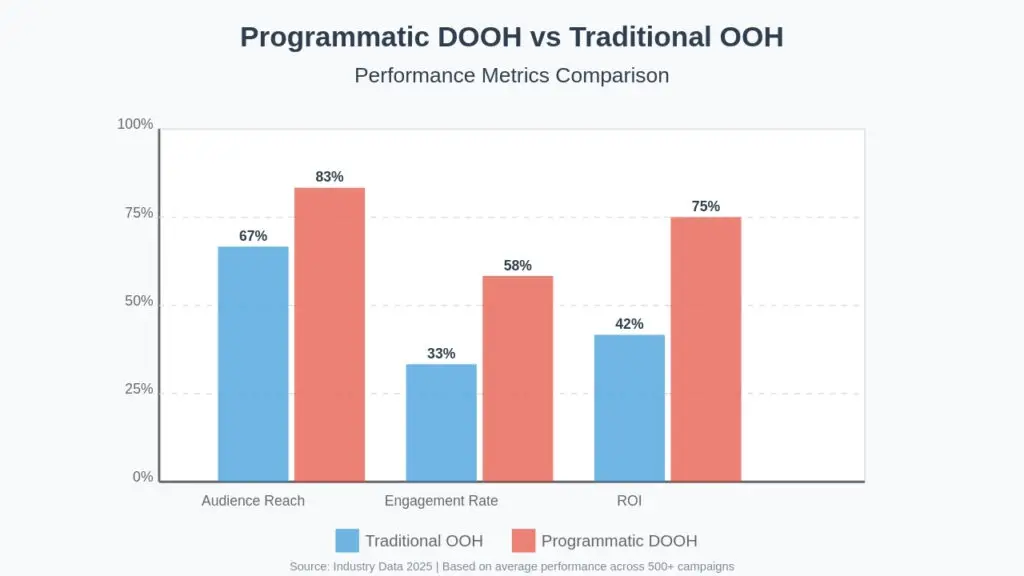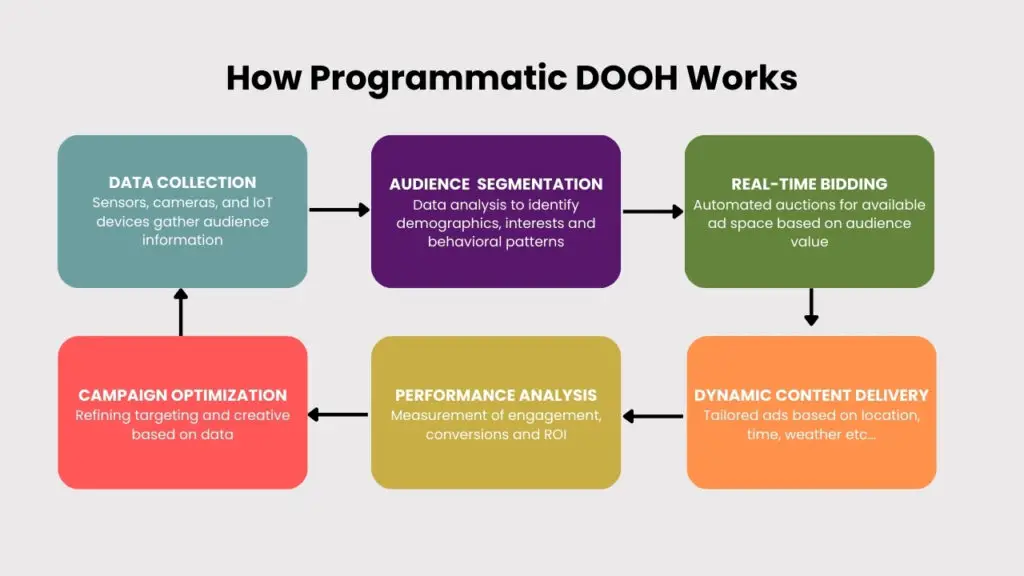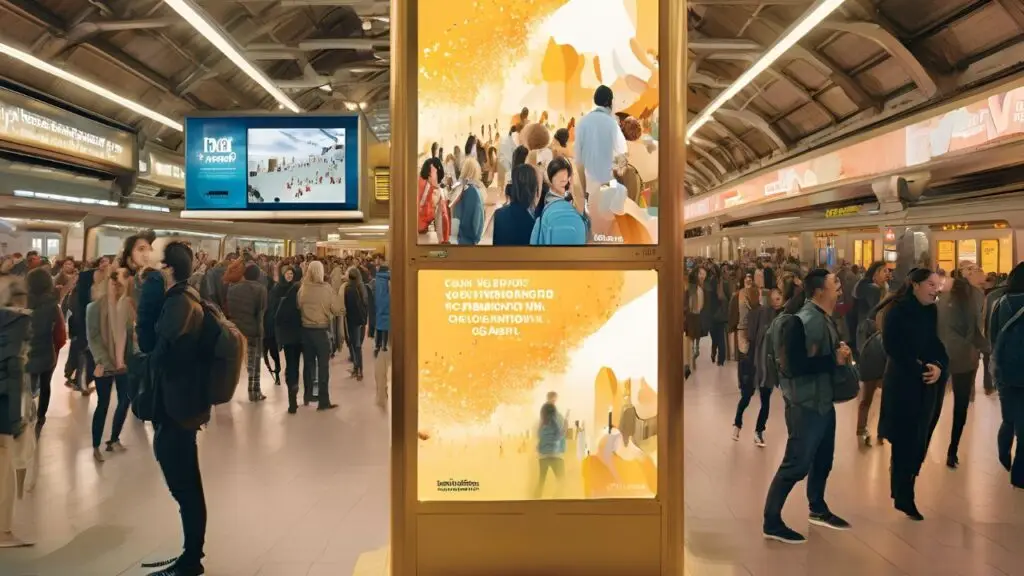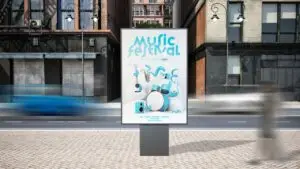Quick Takeaways
- Programmatic DOOH lets you buy digital screen space automatically using real-time bidding
- It delivers 2.8x higher conversion rates compared to traditional outdoor advertising
- Major brands report 24-38% sales lifts when combining programmatic DOOH with retail data
- The technology works for businesses of all sizes with proper strategy and execution
Let’s get real: programmatic DOOH isn’t just marketing jargon. It’s changing how we buy and sell ads on digital screens. If you’re still treating it like a novelty, you’re behind.
I’ve worked in digital signage for almost twenty years. I’ve seen screens change from basic slideshows into smart, targeted messaging platforms. What’s happening with programmatic digital out-of-home right now is different. This isn’t just an upgrade. It’s reshaping everything.
Here’s what you need to know about automated screen advertising in 2025.
What Is Programmatic DOOH, Really?
Let’s ditch the jargon.
Programmatic DOOH (Digital Out-of-Home) is the automated buying and selling of ad space on digital signage screens in public spaces. Think airport displays, digital billboards, mall kiosks, and screens inside retail stores.
Instead of buying space the old-fashioned way (months in advance, flat fee, no flexibility), advertisers now use real-time bidding and data-driven platforms, just like they do online. Only now, those ads show up out there in the real world.
And yes, it’s just as precise and powerful as it sounds.
How Programmatic DOOH Differs from Traditional OOH
| Old Way | Programmatic Way |
|---|---|
| Static content | Changes based on who’s watching |
| Fixed time periods | Flexible, real-time scheduling |
| Hope it works | Target specific people |
| Manual buying process | Automated, algorithmic buying |
| Basic performance metrics | Detailed analytics |

Where You See Programmatic DOOH in Action
Chances are, you’ve interacted with programmatic DOOH and didn’t even realize it. That’s kind of the point.
Retail: Smart shelf-edge displays changing ads based on aisle traffic or shopper profile.
Transit Hubs: Airport screens adjusting content depending on flight schedules or weather delays.
QSR Drive-Thrus: Menus that update based on time of day and inventory levels.
Urban Screens: Billboards that change based on mobile location data or events.
In 2025, programmatic is driving the most innovation in DOOH, especially for brands that want scale, relevance, and accountability.
How Programmatic Digital Out-of-Home Works

At its core, programmatic digital out-of-home operates through a simple but powerful ecosystem:
Demand-Side Platforms (DSPs): These are the tools buyers (brands, agencies) use to bid on inventory.
Supply-Side Platforms (SSPs): These are the tools publishers (media owners) use to sell screen space.
Ad Exchanges: Where those two sides meet to transact in real time.
So instead of a sales rep selling a Times Square screen for three months, a brand can buy 15 minutes on that same screen right now, if the data says it’ll perform.
It’s media buying, but with a brain and an engine.
Key Parts of Programmatic Out-of-Home
Explore the foundational components of programmatic DOOH advertising, from Demand-Side Platforms (DSPs) to Ad Exchanges. Learn how these elements work together to deliver dynamic, data-driven advertising campaigns and discover the industry leaders specializing in each.
Demand-Side Platforms (DSPs)
DSPs are software platforms that allow advertisers to bid on and purchase ad inventory in real-time. These platforms use algorithms and data insights to optimize ad placements, ensuring maximum engagement and ROI. DSPs enable advertisers to target specific demographics, locations, and behaviors with precision.
Key Functions:
- Real-time bidding (RTB) for ad inventory
- Detailed analytics and campaign optimization tools
- Advanced audience targeting capabilities
Top DSP Companies:
- The Trade Desk – Industry leader with comprehensive omnichannel capabilities including DOOH
- Vistar Media – DOOH-specialized platform with global reach and excellent location targeting
- Hivestack – Full-stack programmatic DOOH platform, now part of Perion
- Amazon DSP – Leverages Amazon’s unique audience data for both on and off-Amazon inventory
Supply-Side Platforms (SSPs)
SSPs serve media owners by helping them manage and monetize their digital ad inventory. These platforms make ad spaces available to a variety of buyers, maximizing revenue opportunities while maintaining control over pricing and inventory access.
Key Functions:
- Automated inventory management for screen networks
- Revenue optimization tools
- Quality control and brand safety measures
Leading SSP Providers:
- Broadsign Reach – Industry standard powering 187,000+ digital screens globally
- VIOOH – Premium global SSP trading programmatically in 29 markets
- Vistar Media – Dual-sided platform serving both buyers and sellers
- Place Exchange – Leading SSP for omnichannel programmatic campaigns
Data Management Platforms (DMPs):
DMPs are essential for aggregating, analyzing, and organizing data from multiple sources. They improve the targeting accuracy of advertising campaigns by providing actionable audience insights. By understanding consumer behavior, advertisers can create more effective and personalized campaigns.
Key Functions:
- Aggregation of audience data from various channels
- Audience segmentation and analytics
- Real-time data processing for campaign optimization
Top DMP Companies:
- Adobe Audience Manager – Enterprise-grade audience segmentation and data management
- OnAudience – Specializes in anonymous, GDPR-compliant audience targeting.
- Lotame – Privacy-forward data activation and audience intelligence platform
Get More from Your Screens!
Best Programmatic DOOH Platforms for 2025
The programmatic digital out-of-home landscape is competitive. Here are the key platforms leading innovation:
Enterprise-Level Solutions
Broadsign: The industry standard for large-scale programmatic campaigns. Comprehensive platform handling everything from content management to automated buying.
STRATACACHE: Full-stack solution with strong programmatic capabilities and deep retail expertise.
Vistar Media: Specialized programmatic out-of-home platform with excellent location-based targeting and campaign management tools.
Mid-Market Options
Hivestack: Growing rapidly with user-friendly interfaces and robust analytics. Strong programmatic capabilities for agencies and brands.
Place Exchange: Solid programmatic infrastructure with good integration options for existing systems.
Emerging Players
VIOOH: European-focused platform expanding globally with innovative programmatic solutions.
Campsite: Newer entrant focusing on simplicity and accessibility for smaller networks.
Types of Programmatic DOOH
Not all programmatic digital out-of-home is created equal. To get the best bang for your buck, you need to know which flavor fits your campaign goals. Here’s a quick breakdown of the main types and when to use each:
Real-Time Bidding (RTB): The most common type of programmatic buying, where advertisers bid for ad space in real time.
Programmatic Guaranteed: A direct deal between advertisers and publishers, ensuring ad placements at a fixed price.
Private Marketplace (PMP): A more controlled environment where premium ad inventory is available to select advertisers, offering exclusivity and high-impact placements.
Automated Direct: Pre-negotiated programmatic deals that allow advertisers to secure space without competing in an auction.
By choosing the right type, brands can balance cost, reach, and targeting precision.

Expert Advice, Better Results!
The ROI Argument (Because You'll Be Asked)
Sooner or later, someone’s going to hit you with “but is it worth it?” Here’s your cheat sheet of numbers that prove programmatic DOOH isn’t just cool, it delivers serious results. Let’s talk numbers:
Cost Performance:
- CPMs for programmatic DOOH range between $6 and $24 depending on audience quality and screen location
- Traditional outdoor advertising typically runs 40-60% higher per thousand impressions
- Real-time bidding provides better cost control and budget flexibility
Campaign Results:
- Brands using dynamic DOOH campaigns have reported 2.8x higher conversion rates in retail settings
- Sales lift from DOOH-activated retail media networks has averaged 24–38% when paired with loyalty or POS data
- Brand recall rates for programmatic DOOH average 89% compared to 32% for traditional outdoor
Operational Efficiency:
- Campaign setup time reduced from weeks to hours
- Real-time optimization improves performance by 35% on average
- Instant creative updates save both time and production costs
Bottom line: this isn’t experimental. It’s working. At scale.

Challenges in Programmatic Advertising
Sounds amazing so far, right? But let’s not sugarcoat it, programmatic DOOH still has its pain points. Here’s what you need to watch out for (and why these problems are already on their way out):
Fragmented Standards: Different platforms, different data models, different measurement tools.
Privacy Concerns: Especially in the U.S., the use of mobile data and sensors is under scrutiny.
Limited Inventory: Not all screens are programmatic-ready (though that’s changing fast).
Measurement Gaps: Offline attribution is still maturing. “Opportunity-to-see” doesn’t always mean “impact delivered.”
But these challenges? They’re being solved. Fast. Especially with newer players offering full-stack solutions that blend content, analytics, and AI-powered optimization.
Who's Leading the Pack?
If you’re diving into this space, you’ll want to know who’s setting the pace. These are the key players dominating the programmatic out-of-home media world right now, and the ones you should have on speed dial:
DSPs: The Trade Desk, Vistar Media, Hivestack, Place Exchange
SSPs: Broadsign Reach, Place Exchange, VIOOH
Networks: STRATACACHE, Intersection, Captivate, Firefly
Each has different capabilities, geographies, and strengths. The key is finding one that integrates with your broader media stack and audience targeting needs.

The Future of Programmatic DOOH Advertising
We’ve covered today’s landscape, but what’s next? Here’s a glimpse of where programmatic DOOH is headed, and why the next few years are going to be a wild (and rewarding) ride:
AI Integration: Dynamic creative optimization, predictive placements, and automated campaign tuning are getting sharper and faster.
Retail Media Explosion: RMNs are doubling down on in-store DOOH screens as part of their omnichannel playbooks.
Privacy-Friendly Targeting: Expect more radar and computer vision systems that detect presence without facial recognition.
Contextual Targeting: Weather, traffic, and even social trends will trigger content automatically, not just by campaign brief.
In short: expect smarter, more personalized, and more accountable DOOH experiences. At scale.
Getting Started with Programmatic DOOH
Ready to dive in? Here’s how to approach programmatic digital out-of-home based on where you’re starting:
For Beginners
- Start with a focused budget on one or two platforms
- Create simple, high-contrast creative optimized for screens
- Set up proper measurement and attribution from day one
- Test different audience targeting and dayparting strategies
For Current DOOH Users
- Audit existing systems for programmatic integration capabilities
- Connect current data sources with programmatic platforms
- Train teams on automated buying best practices
- Gradually shift budget allocation from traditional to programmatic
For Advanced Practitioners
- Explore private marketplace opportunities with premium inventory
- Implement sophisticated attribution modeling across channels
- Test emerging technologies like AI-powered creative optimization
- Develop direct relationships with key platform providers
Conclusion: Should You Use Programmatic DOOH?
Yes. If you’re a brand, an agency, a network, or a retailer, the answer is yes.
But only if you treat it like what it is: a dynamic, real-world marketing channel that demands strategy, testing, and thoughtful execution.
Don’t just port your online creative over and hope for the best. Don’t ignore the data.
Programmatic DOOH is here. It’s growing. And it’s changing everything.
Want Help Navigating It?
If you’re building a retail media network, testing DOOH for the first time, or want to audit your programmatic strategy, let’s talk. I help companies make sense of this ecosystem and turn screens into results.
Learn more in my full DOOH Advertising insights archive
FAQ
What is the main advantage of programmatic DOOH over traditional out-of-home advertising?
It allows for real-time targeting and dynamic content delivery, enabling advertisers to display ads based on factors like location, audience demographics, and weather. This flexibility significantly improves engagement and ROI compared to static traditional ads.
How does real-time bidding work in programmatic DOOH?
Real-time bidding (RTB) enables advertisers to compete for ad space dynamically. Using DSPs, advertisers bid for impressions based on audience data, ensuring their ads are displayed to the right viewers at the right time, maximizing campaign effectiveness.
Is programmatic DOOH suitable for small businesses?
Yes, it can be scaled to fit different budgets. Small businesses can use hyper-local targeting and set budget limits to ensure cost-effective campaigns, making it accessible and impactful even on a smaller scale.




